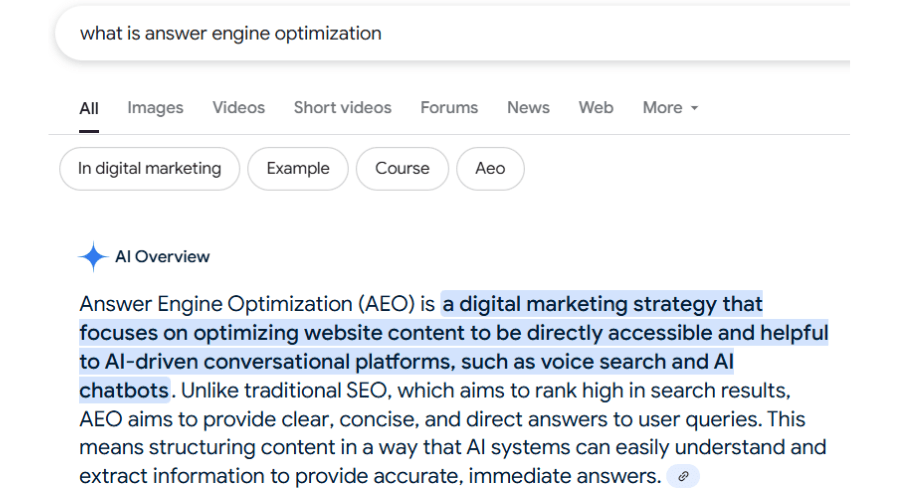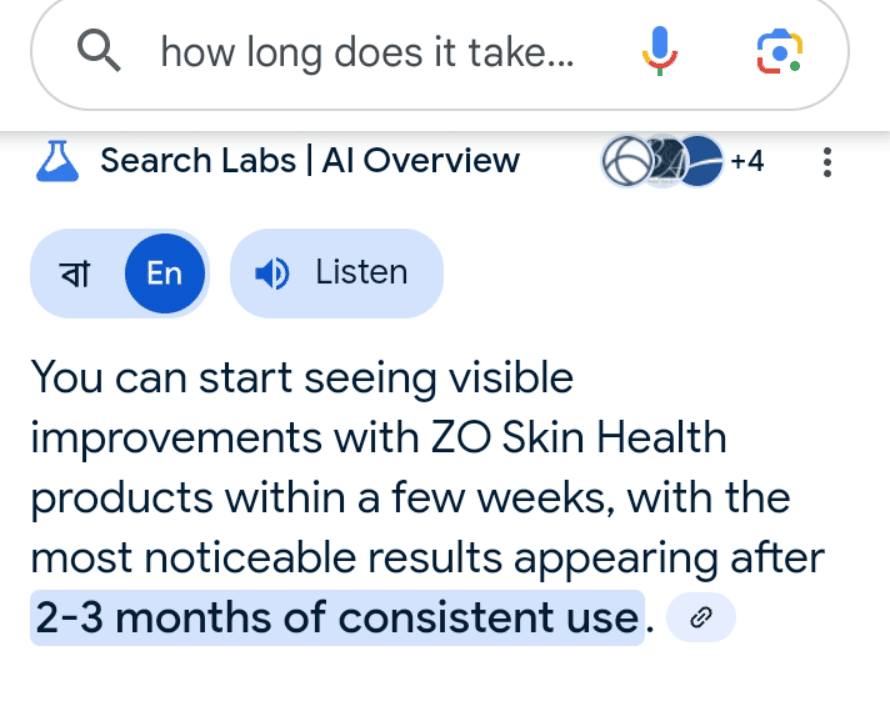The Rise of Answer Engine Optimisation

Search Has Changed
A new approach is rapidly gaining prominence: Answer Engine Optimisation (AEO). This emerging strategy represents a fundamental shift in how content creators must think about visibility in search engines, particularly as artificial intelligence transforms the user experience.
While Search Engine Optimisation (SEO) has dominated digital marketing conversations for decades, AEO acknowledges a new reality: modern search engines are increasingly focused on providing direct answers rather than just links to websites. With the integration of generative AI into search results, users now receive immediate, comprehensive responses to their queries without needing to click through to individual websites.
This transformation represents both a challenge and an opportunity for content creators. The traditional goal of driving website traffic is being complemented—and in some cases supplanted—by the need to have your content featured as an authoritative answer within search results themselves.
What Exactly is Answer Engine Optimisation?
Answer Engine Optimisation (AEO) is the strategic approach to creating and structuring content specifically to be featured in AI-generated answer snippets, featured results, and voice search responses. Unlike traditional SEO which focuses primarily on ranking web pages in search results, AEO targets the increasingly prominent “answer layer” that sits above traditional search results.
This distinction is crucial as search engines evolve from being navigational tools (helping users find websites) to becoming answer engines (directly providing the information users seek). Google’s AI Overview, Bing’s AI responses, and voice assistants like Alexa and Siri all represent this fundamental shift toward answer-focused search experiences.
Key Components of AEO Include:
- Direct Answer Optimisation: Structuring content to directly and concisely answer specific questions
- Snippet Engineering: Formatting content to increase the likelihood of selection for featured snippets
- Conversational Content: Writing in a natural, conversational style that matches how people ask questions
- Structured Data Implementation: Using schema markup to clearly define content types and relationships
- Authority Signaling: Establishing content as a trustworthy, authoritative source for specific topics
The Evidence: Real-World Impact of AEO
A veteran content creator who has produced over 10,000 blog posts recently shared compelling evidence of AEO’s effectiveness. Their experience provides valuable insights into how this approach is already reshaping search visibility.
In their documented case study, a query about “How Long Does It Take to See Results from ZO Skin Health” generated an AI-powered featured snippet that incorporated information from their article, linking directly to their content as an authoritative source. Similarly, their work for a SaaS client in the property management sector achieved prominent placement in AI overviews.

What makes these results particularly significant is that much of their content wasn’t initially created with AEO in mind—it was optimised for traditional SEO with the goal of generating page views. This suggests that content creators who intentionally adopt AEO strategies may achieve even more impressive results.
The Death of the “Sandwich Formula”
One of the most notable revelations from this experienced content creator is the obsolescence of what they call the “sandwich formula”—a once-popular approach where writers would place direct answers immediately after the H1 heading, followed by supporting information.
For example, an article titled “Is it safe to feed leaves to your pet dragon?” would begin with:
“Pet dragons are one of the most popular type of ‘pets’ widely accepted globally, due to their inert nature, and ability to survive in domestic treatment. Yes, it’s safe to feed leaves to your pet dragon, as in their natural habitat, they would anyways have those.”
According to this content veteran, this formula is now “history.” Today’s AI-powered search engines don’t require answers to be positioned at the very beginning of content. Instead, they can identify and extract relevant information from throughout a well-structured article.
Expert Tips for Effective Answer Engine Optimisation
Based on the insights shared by the experienced content creator and additional research, here are structured, actionable tips for implementing AEO in your content strategy:
1. Implement Comprehensive Structured Data
What to do: Go beyond basic schema markup to implement detailed structured data that clearly communicates content organisation and relationships.
How to implement it:
- Use ListItem schema for content organised as steps, lists, or rankings
- Implement WebPage schema to communicate overall content purpose
- Include FAQ schema for question-based content sections
- Add HowTo schema for instructional content
- Ensure Product schema is correctly implemented for product-related content
Why it works: Structured data provides clear signals to search engines about content organisation, making it easier for AI to identify and extract relevant information for answers.
2. Strategically Position Comprehensive Answers
What to do: Instead of forcing answers into a specific location, focus on creating clear, comprehensive answers within logically organised sections.
How to implement it:
- Create descriptive, question-based headings (H2, H3) that match search queries
- Provide complete, self-contained answers under each relevant heading
- Use bullet points and numbered lists to organize information clearly
- Place the most important information at the beginning of each section
- Ensure each section could stand alone as a coherent answer
Why it works: Modern search algorithms can identify relevant content throughout an article, not just at the beginning, allowing for more natural content organization.
3. Optimise for Voice and Conversational Search
What to do: Write in active voice with natural language patterns that match how people actually speak and ask questions.
How to implement it:
- Prioritise active voice over passive constructions
- Use first and second person pronouns where appropriate
- Include conversational transition phrases
- Keep sentences direct and concise
- Test content by reading it aloud to ensure it sounds natural
Why it works: Voice search and AI-generated answers favor content that matches natural speech patterns, making active voice content more likely to be selected.
4. Use AI Strategically in Content Development
What to do: Leverage AI tools to understand how answer engines might interpret and summarise your content.
How to implement it:
- Create comprehensive content first (1,000+ words on the topic)
- Use AI to generate a concise 2-3 sentence summary of that content
- Incorporate that summary style into your content (not necessarily verbatim)
- Compare your content structure against AI-generated answers for your target queries
- Identify and fill gaps in your content based on AI responses
Why it works: This approach helps you understand and align with the patterns that AI systems use when generating summarised answers.
5. Focus on E-E-A-T Signals Throughout Content
What to do: Emphasise Experience, Expertise, Authoritativeness, and Trustworthiness signals that help AI systems identify your content as a reliable source.
How to implement it:
- Include credentials and qualifications of content creators
- Reference authoritative sources with proper citations
- Incorporate first-hand experience and original insights
- Update content regularly to ensure accuracy
- Provide comprehensive coverage that addresses common questions
Why it works: AI systems are designed to prioritize trustworthy information from authoritative sources, making E-E-A-T signals increasingly important for AEO.
6. Conduct Regular SERP Analysis for Target Queries
What to do: Regularly analyse how search engines are currently handling your target queries to identify opportunities and adjust your strategy.
How to implement it:
- Search for your target queries in private/incognito mode
- Note which content is selected for AI overviews and featured snippets
- Analyse the format, length, and style of featured content
- Identify patterns in how information is presented
- Adjust your content to align with successful patterns
Why it works: Search presentation is constantly evolving, and regular analysis helps you stay aligned with current AI preferences.
The Future of Content in an AEO World
As answer engines become more sophisticated, content strategy must evolve accordingly. The future will likely include:
1. Hybrid Optimisation Models
Successful content will need to balance traditional SEO (to drive traffic) with AEO (to establish authority in AI-generated answers).
2. Enhanced Structured Content
More granular content structuring will become essential, with clearer delineation between different types of information.
3. Content Atomisation
Breaking comprehensive content down into clearly defined, interconnected modules that can be reassembled by AI systems for different queries.
4. Collaborative AI Content Development
Using AI tools not just for research and editing but as collaborative partners in understanding how content will be processed and presented.
5. Authority-Focused Analytics
New metrics that track how frequently and prominently content is featured in AI answers, not just traditional traffic and engagement metrics.
Conclusion: Adapting to the Answer Economy
The emergence of AEO represents a fundamental shift in how we must think about content visibility. While traditional SEO won’t disappear, the growing prominence of AI-generated answers means content creators must adapt their strategies to remain visible in this new paradigm.
By understanding the principles of Answer Engine Optimisation and implementing structured approaches to content development, marketers and content creators can position themselves for success in this evolving landscape. The goal is no longer just to rank well in search results but to be recognised by AI systems as the authoritative source worth featuring directly in answers.
Those who master this transition will find new opportunities to establish authority and visibility, even as the traditional metrics of online success continue to evolve.






